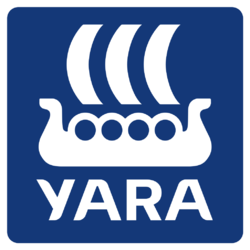Yara International
(Multinational corporation, Big Agriculture, Big Chemical) | |
|---|---|
 | |
| Formation | 1905 |
| Headquarters | |
| Interests | synthetic fertilisers |
| Member of | WEF/Strategic Partners |
| Membership | • Svein Tore Holsether • Thor Giæver • Lars Røsæg • Mónica Andrés Enríquez • Solveig Hellebust • Pål Hestad • Terje Knutsen • Fernanda Lopes Larsen • Chrystel Monthean • Kristine Ryssdal |
| Chemical company that is one of the world’s largest producers of synthetic fertilisers | |
Yara International ASA is a Norwegian chemical company that is one of the world’s largest producers of synthetic fertilisers. [1][2] however it also encompasses the production of nitrates, ammonia, urea and other nitrogen-based chemicals.
The company was established in 1905 as Norsk Hydro — the world's first producer of mineral nitrogen fertilizers — and de-merged as Yara International ASA on March 25, 2004.[3] Yara is listed on the Oslo Stock Exchange and has its headquarters in Oslo. The company has around 13,000 employees, production sites on six continents, operations in more than 50 countries and sales to about 150 countries.[4]
The Norwegian government owns more than a third of Yara and is its largest shareholder.[5]
International agricultural agenda
Yara invests millions in shaping the international agricultural agenda.[6]
Yara has stimulated fertiliser sales across Africa through skilfully wrapping itself in a humanitarian mantle. It created the Yara Foundation in 2005 to “support the fight against hunger in Africa”. In 2016, the first of three annual African Green Revolution Conferences took place in Oslo. The conferences built momentum for a more structured partnership, whereby there is now an annual African Green Revolution Forum co-sponsored by Yara, as well as agencies such as UKAID and companies like the GM-seed company Syngenta.[7]
Yara is part of the New Alliance for Food Security and Nutrition, which is a “co-operation framework” that launched at the 2012 G8 Summit in the US. It aims to “accelerate responsible investment in African agriculture and lift 50 million people out of poverty by 2022”. The alliance brings together African governments, private sector companies like Monsanto and donor partners, including the Melinda and Bill Gates Foundation.[6]
The approach of all of these initiatives is to move people away from subsistence and smallholder agriculture into capitalist production growing for commodity markets.
Raw materials
As well as making fertiliser, Yara sells ammonia it produces to other industries, such as textiles, cars, healthcare and cosmetics. Yara says it trades “about one-third of the world’s ammonia with plants across the world”.[8] Yara is Europe’s biggest industrial buyer of natural gas.[9]
Two other big ingredients it needs are potash and phosphates. Yara is the world’s second largest buyer of potash, as well as mining some itself. It is the world’s third largest buyer of phosphates.[6]
Board members
The board members listed (above right) are from November 2021.[10]
References
- ↑ http://www.economist.com/businessfinance/displaystory.cfm?story_id=15549105
- ↑ https://www.bloomberg.com/apps/news?pid=20601082&sid=aMuZb_eEC0KU&refer=canada
- ↑ https://newsnreleases.com/2020/12/06/yara-international-asa/
- ↑ https://web.archive.org/web/20120101152718/http://www.yara.com/investor_relations/company_overview/index.aspx
- ↑ https://next.ft.com/content/c890a00a-4e2c-11e4-bfda-00144feab7de
- ↑ Jump up to: a b c https://corporatewatch.org/yara-the-fertiliser-giant-causing-climate-catastrophe/#Influence
- ↑ https://agrf.org/
- ↑ https://www.yara.com/chemical-and-environmental-solutions/process-chemicals/ammonia/
- ↑ https://www.yara.com/siteassets/investors/057-reports-and-presentations/annual-reports/2018/yara-annual-report-2018-web.pdf/
- ↑ https://www.yara.com/this-is-yara/management-and-board/
Wikipedia is not affiliated with Wikispooks. Original page source here